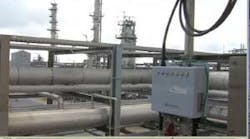While struggling to survive bankruptcy in the early 2000s, Huntsman Corp., The Woodlands, Texas, significantly reduced personnel and some key services. These cuts impacted safety and environmental performance. Reportable safety issues at the company's Port Neches, Texas, facility increased to 45 and reportable environmental releases hit 116 in 2004!
With the leadership of John Prows, vice president of manufacturing of the Huntsman Performance Products Division, and others, as well as initiatives like behavior-based training, Huntsman Port Neches was able to bring these levels closer to industry norms. In 2007, the safety number was down to 33 and reportable environmental releases were below 20. But the questions remained: "How do we follow the company's core values and drive unwanted incidents to zero? How do we go the 'last mile'?"
Prows believed the answer could be found in technology that would give the field operators and maintenance personnel crucial safety-critical and operational data. The idea was that if plant personnel knew the operating limits of critical equipment, they would be able to make safer and more operationally effective decisions. Also, by identifying, capturing and beginning the process of remediating defects in the field, both equipment safety and uptime would dramatically improve.
This vision became "Project Zero."
Implementation
Running cables or lines to field equipment is expensive and avoiding significant signal noise can pose a challenge. So, to help deliver on the objectives of Project Zero, Huntsman decided to pursue a wireless strategy. It partnered with Industrial Mobility, The Woodlands, Texas, Apprion, Moffett Field, Calif., and Motorola, Schaumburg, Ill.
Huntsman and Apprion began implementing a plantwide network in May 2008 on 400+ acres of the Port Neches production area. To provide Huntsman with complete coverage for access to critical data anywhere and at anytime, more than 90 IONizers, Apprion's multi-radio, multi-protocol access points, were installed (Figure 1). The network was engineered with the future in mind — it was enabled with VoIP capabilities and scalable to support many other applications of wireless technologies going forward.
Figure 1. More than 90 such points enable full and continuous access to critical data.
Simultaneously, Huntsman and Industrial Mobility worked to find, clean up or create critical data needed to bring the plant to world-class levels. This effort included converting Word-based procedures to a step-executable format for use on handheld computers and developing more than 1,200 standard operating conditions (SOC) for guiding field workers in making decisions at the point of need.
Industrial Mobility's MobilOps software brought database-driven functionality for finding, managing and displaying "one source of truth" for operating procedures, SOC, rounds, environmental compliance checklists and other key documents. Additionally, integration was provided for MobilOps to access equipment identification from Huntsman's computerized maintenance management system (CMMS).
A passive RFID tag was placed on each piece of equipment in the field. This enables a field worker to locate that particular item in the database and all documentation about it simply by using a Motorola MC9090 handheld to scan the RFID tag.
Likewise, a defect can be captured just by scanning the RFID tag and entering information about the defect. This information is immediately sent to the CMMS system for maintenance to schedule work. There're no more duplicate work orders or, worse, ignored defects, as happened with the prior cumbersome approach.
If, after scanning the tag, the field worker enters a process variable (temperature, pressure, vibration, level, etc.) that's outside of determined limits (SOC), the handheld automatically gives an alert. This shows the consequences of being out of range (consequences of deviation) and suggestions to remediate (corrective actions).
Checklists accessible via the MC9090 handheld cover all process equipment requiring field monitoring. Almost immediately operations staff added safety-shower and fire-extinguisher checklists to the database.
The combination of database and mobile-enabled wireless technology make the possibilities for reporting and process improvement virtually endless.
One key challenge with any new technology is getting "buy in." This issue became a non-starter when field operations staff began using the system. Port Neches field operators are the biggest supporters of the new mobility solution.
Impressive Results
The system went live in May 2009 and now is deployed at more than 70% of the plant with complete coverage expected this summer. It's already markedly improved the number of defects captured and reduced redundant efforts.
Pumps were initially a prime focus because they promised an immediate work-reduction opportunity.
The program has identified certain equipment that fails more frequently than others. There's a "bad actor" list of pumps; similar lists are being developed for other equipment like compressors and heat exchangers. This enables staff to prioritize. Bad actors get more frequent checks than other equipment.
Response time to address defects has dropped dramatically. What before might have taken three weeks now often only takes a day or, at worst, a week.
Next steps include a Six Sigma study, expanding the solution to additional plants, and deploying more wireless applications, e.g., for tank level monitoring, railcar and hazardous-material tracking, and emergency notification.
Kim Hoyt is manufacturing excellence manager for Huntsman Corp., Port Neches, Texas. E-mail her at [email protected].

